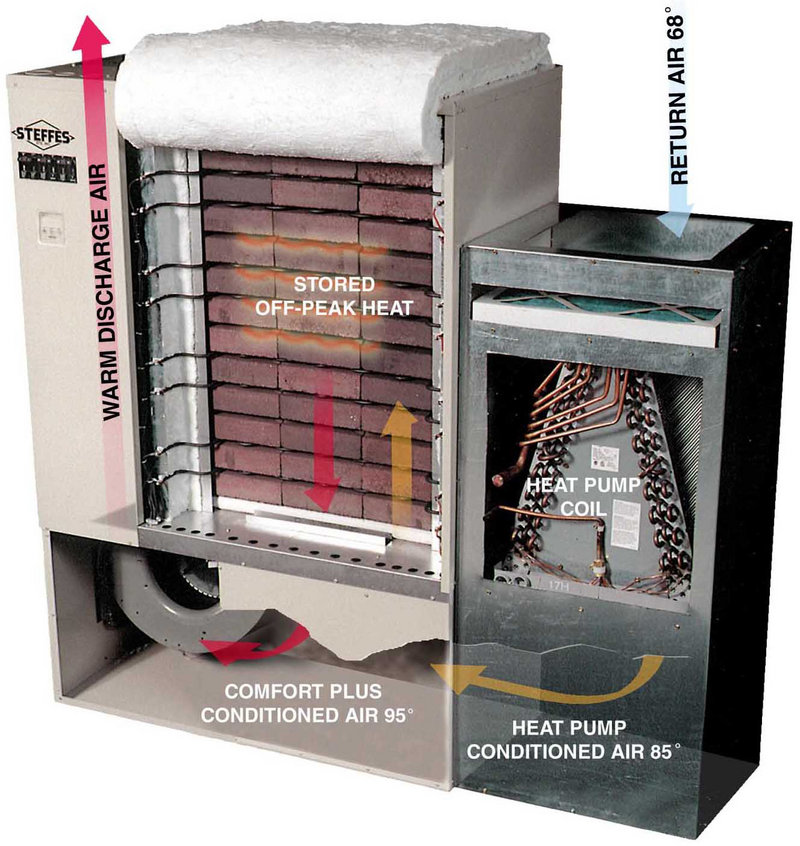The concept of heating with the wind, and reducing Maine’s dependence on imported oil, is an appealing one. But it’s not as simple as hooking up homes to spinning turbines. The Highland Wind project offers a glimpse of how the proposal would work technically, and also a sense of its limitations.
Highland Wind LLC is offering residents of Highland Plantation $6,000 grants for energy options that include the installation of electric thermal storage heaters. The heaters are common in Europe and some American states. Their insulated cabinets are packed with dense, ceramic bricks that absorb electric heat during off-peak hours, when power is less expensive, then release it with the help of a thermostat and blower.
As an incentive, Highland Wind will provide the power at a cost that equals heating oil at $1.15 a gallon. That’s a steep discount from market prices.
Highland Wind is a subsidary of Brunswick-based Independence Wind, led by former Gov. Angus King and Rob Gardiner, a past president of the Maine Public Broadcasting Network. King and Gardiner see the integration of wind and heat as a good match for Maine. The strongest winter winds blow at night, when the regional grid has excess capacity. Winter also is when Maine has its highest demand for electricity, they point out.
But the wind doesn’t blow all the time, even in winter. Highland Wind is projecting a 35 percent capacity factor, a measurement of the annual output of turbines compared to their maximum possibility.
That’s relatively high for a Maine wind project, but not enough to rely on completely. Because of the wind’s variability, the electricity for the storage heaters wouldn’t come directly from the project’s 39 turbines. All the wind power generated would go into the regional transmission grid, and a portion of the output would be earmarked for Highland Plantation.
The room-unit storage heaters being offered for the demonstration project cost roughly $3,200 each. They must be hardwired to a house with at least a 100-amp service. Homes with lesser wiring would need upgrades.
Homeowners also would need to maintain a second heat source. The room units are big enough to supply only 60 percent of a typical home’s heating demand.
As an added benefit, all residents would be offered free electricity for the 20-year life of the project. That give-away would be capped at 500 kilowatt hours in the summer, and 750 kwh in the winter, which reflects average residential consumption. And the subsidy would be only for the energy portion of the bill — worth 6-7 cents per kwh — not the delivery side.
Highland Plantation has 26 residences. King and Gardiner realize that not everyone will be interested. They’d like a handful of homes to sign up, at first. They hope in time to get a dozen or so units installed, after neighbors see how it works.
Despite the obstacles, Highland Wind’s developers say this approach could serve as a model for other wind projects in Maine, if a portion of the power is earmarked for local heating.
The concept is likely to get a boost later this year. Maine utility regulators are reviewing a special, off-peak rate for thermal storage electricity. That would allow homes to receive overnight power at a lower, fixed rate that could make the heaters competitive with oil and kerosene units.
Staff Writer Tux Turkel can be contacted at 791-6462 or
tturkel@pressherald.com
Send questions/comments to the editors.




Success. Please wait for the page to reload. If the page does not reload within 5 seconds, please refresh the page.
Enter your email and password to access comments.
Hi, to comment on stories you must . This profile is in addition to your subscription and website login.
Already have a commenting profile? .
Invalid username/password.
Please check your email to confirm and complete your registration.
Only subscribers are eligible to post comments. Please subscribe or login first for digital access. Here’s why.
Use the form below to reset your password. When you've submitted your account email, we will send an email with a reset code.